Abstract
Some previous studies on Spirulina platensis show that this species contains pigments that can be used as natural dyes in textiles. However, research on the usage of spirulina natural pigment in certain types of conventional textile handicraft home industries in Indonesia has not been conducted. The purpose of this study is to utilize the potential of Spirulina platensis as homemade natural dyes for the development of designs in textiles. Through an experimental methodology, various experiments starting from the extraction process and dyeing were conducted to find out the right way to produce home dyes using spirulina and techniques of surface textile design to apply them in textiles. This is useful as one of the solutions today, since an increasing number of consumers are consciously seeking sustainable products, with no exception to the types of textile products. Therefore, this will provide an opportunity for business collaboration ideas in agribusiness and craft textiles. Additionally, it can add to the nature of textile natural dyes derived from various plant species in Indonesia.
1 Introduction
Before synthetic dyes were as popular as they are today, ancient humans were familiar with various types of plants used as natural dyes in textiles. Previously, the use of natural dyes in textile industry was not as popular as synthetic dyes due to several weaknesses. Approximately only 1% of natural dyes were used in the textile sector. This happened due to problems such as unavailability of dyes in standard ready-to-use forms, limited and non-reproducible colors, inability to meet huge demands, and prevention of resource overexploitation to get natural resources of natural dyes. Therefore, various research efforts have been carried out around the world to address this problem, given the enormous benefits to the environment and its prospects for the future economic sector [1].
In fact several studies of the potential of these natural dyes are slowly starting to increase again because they are considered important [2]. This is driven by an increase in human concern over the decline in environmental quality due to the high number of pollution and waste generated from the remnants of the production in the textile industry which adversely affect human survival itself [3]. The impact caused by the use of synthetic dyestuffs on life is very bad. The presence of naphthol, vat dyestuffs, nitrates, acetic acid, soaping chemicals, enzymatic substrates, chromium-based materials, and heavy metals has clearly become a very dangerous water waste [4].
Therefore, to overcome this problem, many have began to return to the use of eco-friendly materials and safe production processes to maintain environmental and natural sustainability. In addition to conducting a brief review of natural colorants from plant sources and their classification, technically, experiments were also carried out on technical procedures for the natural dyeing process [5], including the use of natural mordant and fixation to determine the effect on the resulted color, that is the strength of color against fading, brightness as well as new color variations created [6,7].
The search for potentials of natural dyes for textiles is continuously carried out on various types of natural resources in animals, plants, and minerals that contain strong color pigments that can be applied to fabrics. It is implemented not only by discovering new natural sources but also by experimenting on various types of natural sources that have been found a long time ago and by developing them to get new color references in textiles [7,8]. One of them is Spirulina platensis which is a planktonic organism that is autotrophic. It does not have a true cell nucleus (prokaryotic), and is shaped like a spiral-like filament with blue-green color. This spirulina is widely cultured and sold commercially in both fresh and dried form as a food supplement [9]. In addition, this spirulina has been known to contain biopigments, including chlorophyll, carotene, xanthophyll, and phycocyanin, and is also known to have many benefits for humans [10,11], especially, phycocyanin biopigments that contain blue pigments which are known to be very potential for natural dyes have been developed into a variety of food and cosmetic products [12,13].
Meanwhile, in the textile sector, Blond & Bieber, a design studio in Germany, has recently developed research results by utilizing the potential of various types of microalgae, including Spirulina platensis as a natural dye to be applied to motifs on fabric and subsequently made into various fashion products. The spirulina pigment extraction process was carried out in a laboratory by applying various measured variables to get the optimal color [14].
The great potential of spirulina to become one of the promising alternatives to be developed in Indonesia as a natural dye, certainly, needs to be linked to the condition of the industry itself. As explained by Ciptandi [15], efforts to implement an innovation into a community group or community-based industry need to consider the suitability of conditions in the community. The goal is not to force certain innovation, but to offer appropriate technology. In Indonesia, the industrial model engaged in the textile sector is not only in the form of small to large scale industries, but there are also types of home industries that still produce textiles and textile crafts in a conventional way [16].
The development of this natural Spirulina platensis dye also needs to be developed in home industries in Indonesia by looking at the readiness of the industry which still carries out all its production processes conventionally. This objective is carried out by means of experiments with conditions adapted to the conditions of the industry with a homemade approach through the dye extraction stages and surface textile design. Therefore, in this way, the right homemade method for extracting natural Spirulina platensis dyes and textile design techniques for making motifs on fabrics can be found.
2 Research methods
This study used a Spirulina platensis, and the methodology was carried out in three stages, namely, the experimental stage of dyeing cloth, the experimental stage of surface textile design, and testing stage of dyeing fastness to domestic laundering.
2.1 Fabric dyeing experiment stage
This stage began with the extraction of dye and paste making which was done simply by removing the water content in the spirulina using an oven, then grinding it into a powder. Furthermore, the fabric was dyed using the hot and cold methods. This method followed the standard process of dyeing natural dyes in general which was carried out conventionally, as shown in Table 1.
Experimental variables of cold and hot dyeing on fabrics using Spirulina platensis powder
| Techniques | Dyeing process |
|---|---|
| Cold dyeing | Tools and materials: |
| 5 g spirulina powder, 2 L of water, 15 mL of Al2(SO4)3 as a color generator, 100% cotton cloth, and dyeing container | |
| Process: | |
| 1. Mixing spirulina powder into aqueous solution and aluminum sulfate | |
| 2. Soaking 100% cotton cloth in the solution for 8 h | |
| 3. Lifting the cloth that has been soaked in the dye solution | |
| Hot dyeing | Tools and materials: |
| 5 g spirulina powder, 15 mL of Al2(SO4)3 as a color generator, 2 L of water, 100% cotton cloth, and dyeing container | |
| Process: | |
| 1. Mixing spirulina powder into aqueous solution and aluminum sulfate | |
| 2. Soaking 100% cotton cloth into the dye solution under hot conditions while the stove is on | |
| 3. Lifting the cloth after 15, 30, and 60 min |
The process was continued with an experimental stage as shown in Table 2, that is making natural dye paste as an alternative to be able to apply the spirulina color pigment to fabrics. The paste making was done by mixing ingredients that can be obtained easily, including spirulina powder, alginate powder dissolved in water as a gelling agent which functioned as a thickener [17], and glycerin which functioned as a moisture guard for the paste so that it does not dry out easily [18]. All these ingredients were mixed and dissolved in water.
Experimental variables of making Spirulina platensis natural dye paste
| No. | Constants | Variables |
|---|---|---|
| 1 | Spirulina powder + water | 5% Alginate + 5% glycerin |
| 2 | Spirulina powder + water | 5% Alginate + 10% glycerin |
| 3 | Spirulina powder + water | 10% Alginate + 5% glycerin |
| 4 | Spirulina powder + water | 15% Alginate + 5% glycerin |
| 5 | Spirulina powder + water | 15% Alginate + 10% glycerin |
| 6 | Spirulina powder + water | 20% Alginate + 5% glycerin |
| 7 | Spirulina powder + water | 20% Alginate + 10% glycerin |
| 8 | Spirulina powder + water | 20% Alginate + 15% glycerin |
This experiment aimed to find the most appropriate concentration of paste to be applied to the surface of the fabric by varying the composition of alginate and glycerin and keeping spirulina powder and water as constants.
The resulted paste was tested on fabrics to identify the characteristics of each potential paste concentration.
2.2 Experiments on surface textile design with Spirulina platensis natural dyes
The next experiment was the application of natural spirulina dye paste on fabrics by carrying out three stages of the process as shown in Figure 1. This experimental stage was carried out to identify the potentials of spirulina natural dye application using surface textile design techniques, namely screen printing, to produce motifs on textiles.
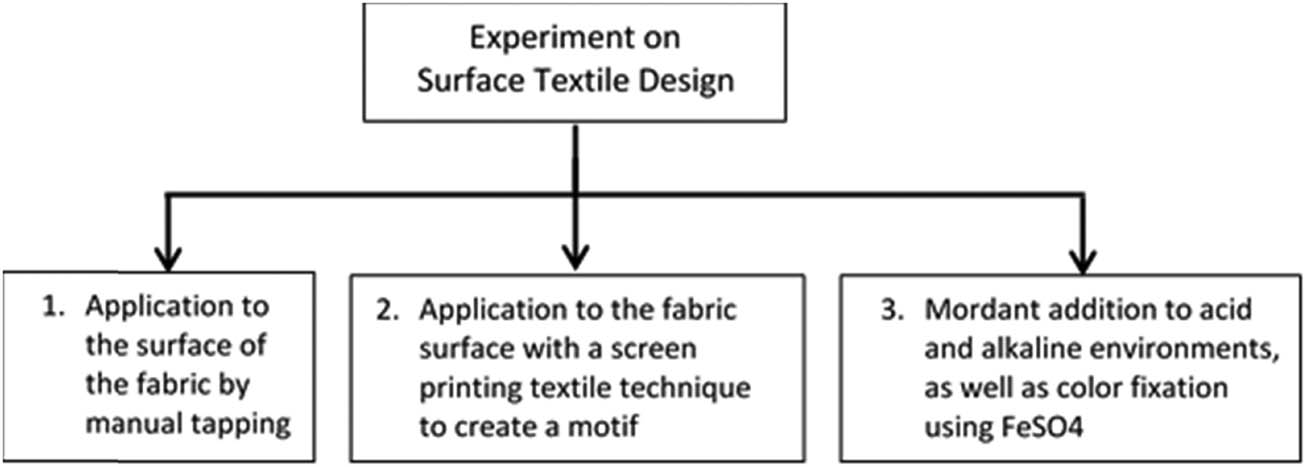
The experimental process stage of applying color to fabrics with surface textile design techniques.
2.3 Testing
The final stage was the testing of dyeing fastness to domestic laundering in accordance with the Indonesian National Standard, ISO 105-C06: 2010 with the test conditions according to Table 3.
Test condition of color fastness to domestic laundering
| Temperature (°C) | Liquor volume (mL) | Available chlorine (%) | Sodium perborate (g/L) | Time (min) | Number of steel balls | Adjust pH to |
|---|---|---|---|---|---|---|
| 40 | 150 | None | 1 | 30 | 10 | Not adjusted |
3 Results and discussion
All stages of the experiments in this study were conducted by considering the readiness of the home textile industry which still conducts the entire production process conventionally.
3.1 Results of dyeing the fabric and applying Spirulina platensis dye paste
The first stage began with extracting spirulina and dyeing the fabric by hot and cold methods. This method followed the standard process of dyeing natural dyes in general which was done conventionally according to Table 1. After the dyeing process, the results are as shown in Figure 2.
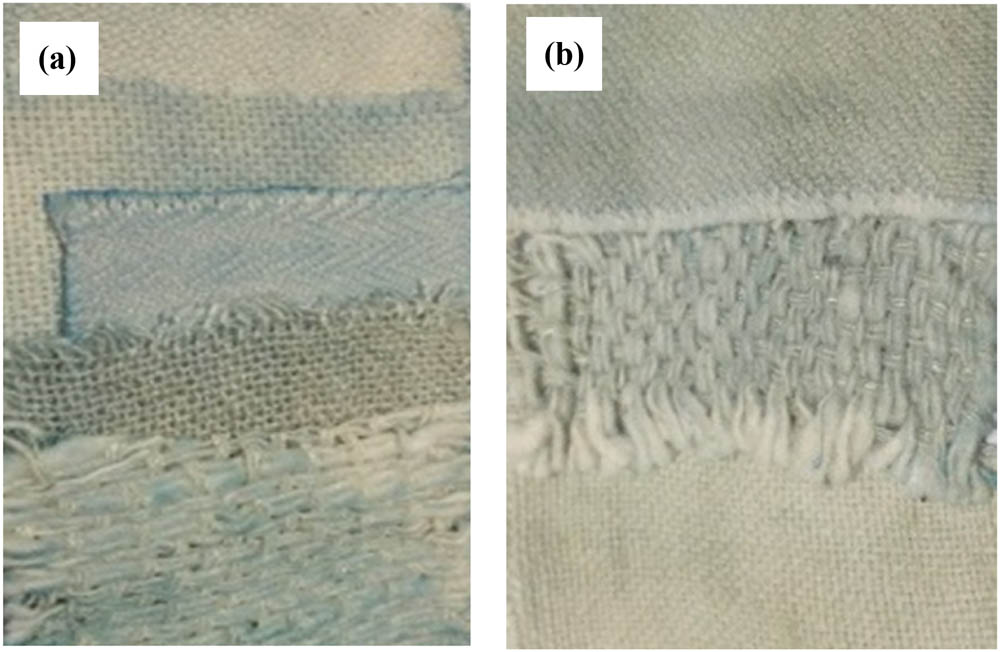
Results of dyeing experiments on fabric using spirulina powder: cold dye (a) and hot dye (b).
Based on the extraction and fabric dye experiments, it was known that the colors did not stick well. Although the dyeing time had been adjusted to see whether the time variable affects the absorption of the color in the fabric, it was known that the results were not significant. So it could be concluded to be a failure. Therefore, the experimental stage of making a natural coloring paste was then proceeded as an alternative to make it possible to apply spirulina color pigments to the fabric. The process is shown in Table 2, and the results are shown in Table 4.
Result of experiment of making Spirulina platensis natural coloring paste
| Variables | Composition | Analysis | Decision |
|---|---|---|---|
| 1 | 3 g Powdered spirulina + 40 mL of water + 2 mL of alginate + 2 mL of glycerin | The mixture was too liquid and difficult to adjust | Damaged |
| 2 | 3 g Powdered spirulina + 40 mL of water + 2 mL of alginate + 4 mL of glycerin | The mixture was too liquid and could not be adjusted | Damaged |
| 3 | 3 g Powdered spirulina + 40 mL of water + 4 mL of alginate + 2 mL of glycerin | The mixture thickened well so it was easy to manage, but the paste only stayed moist for less than 3 min before it dried | Successful |
| 4 | 3 g Powdered spirulina + 40 mL of water + 6 mL of alginate + 2 mL of glycerin | The mixture tended to thicken with a concentration tending to be liquid but was still easy to adjust and the moisture of the paste could last up to 3 min before it dried | Successful |
| 5 | 3 g Powdered spirulina + 40 mL of water + 6 mL of alginate + 4 mL of glycerin | The mixture thickened well and was still adjustable with the moisture of the paste which could last up to 5 min before it dried | Successful |
| 6 | 3 g Powdered spirulina + 40 mL of water + 8 mL of alginate + 2 mL of glycerin | The mixture was too thick that it was difficult to adjust and the paste would stay moist only for less than 3 min before it dried | Damaged |
| 7 | 3 g Powdered spirulina + 40 mL of water + 8 mL of alginate + 4 mL of glycerin | The mixture thickened well so it was easy to manage and the paste’s moisture could last up to 5 min before it dried | Successful |
| 8 | 3 g Powdered spirulina + 40 mL of water + 8 mL of alginate + 6 mL of glycerin | The mixture thickened with thickening concentration and was still easy to adjust with the moisture of the paste that could last up to 10 min before it dried | Successful |
Based on Table 4, several successful variables of spirulina dye paste were obtained. The consideration in deciding the paste being successful was that the condition of the paste in the form of both liquid and thick concentrations can be adjusted and shaped according to the purpose, as well as the moisture of the paste before it finally dried. This was important for the next stage when the paste would be applied on the fabric to form a motif. The paste should be adjustable in order to form the desired motif, and not dried out quickly when the process of making the motif was being carried out. As shown in Table 5, it was decided to choose 2 recipes for ingredients that were considered the best, i.e. paste of variable 5 and 7. Then, the paste would be tested to be applied on the fabric surface.
Concentration variable of selected Spirulina platensis color paste
| Composition | Images | Notes | Result of application on fabrics |
|---|---|---|---|
| 3 g Spirulina powder + 40 mL of water + 6 mL of alginate + 4 mL of glycerin |
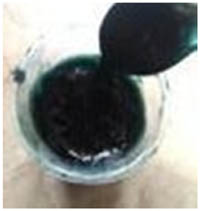 |
Deep green color paste; however, when applied to the fabric, bluish color appeared from the phycocyanin biopigment |
 |
| 3 g Spirulina powder + 40 mL of water + 8 mL of alginate + 4 mL of glycerin |
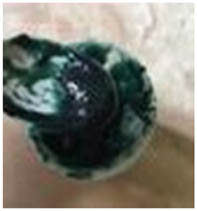 |
Thick green color paste; however, when applied to the fabric, bluish color appeared from the phycocyanin biopigment |
 |
3.2 Results of surface textile design experiment with Spirulina platensis natural dyes
The next stage of the experiment as shown in Table 6 was to apply the paste on the surface of two types of fabric, namely cotton and linen, and then to see the final result after rinsing without previously adding the mordant process. Meanwhile, as shown in Table 7, the next stage was to apply a paste on textiles by applying one of the surface textile design techniques, namely screen printing, on cotton and to add mordant Al2(SO4)3 as a color binder on the fabric [19]. In addition, the motif exploration process was also carried out to measure the ability of the paste to print the motif on the fabric.
Experiments on Spirulina platensis paste application on fabric
| Paste type/cloth | Before rinsing | Notes |
|---|---|---|
| Paste variable 5 |
 |
– The final color produced was greenish, not significant both in cotton and linen |
| – The shape of the motif could be printed well | ||
| – Had strong characteristic results of handmade and differed from color characteristics of digital printing techniques | ||
| Paste variable 7 |
 |
– The final color produced was greenish, not significant both in cotton and linen |
| – The shape of the motif could be printed, but color was not evenly distributed, there were certain parts that looked thinner than other parts. However, this actually gave transparent-like color effect | ||
| – Had strong characteristic results of handmade and differed from color characteristics of digital printing techniques | ||
| Mixture of paste on cotton |
 |
The shape was printed well, greenish and uneven. The result of mixture of paste was not significant |
Experiments on Spirulina platensis paste application on cotton with screen printing and fixation
| Materials | Screen printing stage 1 | Screen printing stage 2 | Final result |
|---|---|---|---|
| 100% Cotton, paste variable 7 + mordant solution Al2(SO4)3 without fixation |
 |
 |
|
| 100% Cotton, paste variable 7 + mordant solution stages 1 and 2 Al2(SO4)3 |
 |
 |
 |
| 100% Cotton, paste variable 7 + mordant solution stages 1 and 2 CH₃COOH (acetic acid) |
 |
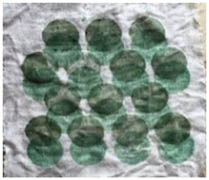 |
 |
| 100% Cotton, paste variable 7 + mordant solution/stage 1 Al2(SO4)3 , and fixation/stage 2 FeSO4 |
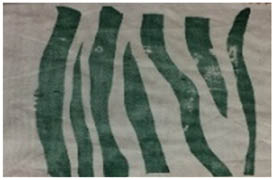 |
 |
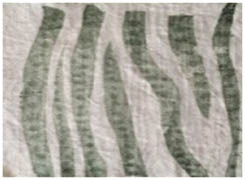 |
Based on Table 7, the results of the experiments on spirulina paste application on fabric with screen printing and fixation were as follows:
The shape and composition of the motif could be formed properly. This showed that the concentration of the paste used was good, so there were no obstacles in the incision process on the fabric.
The addition of fixation helped the color that had been etched on the fabric to stick well.
The addition of the dyeing process to the mordant solution and fixation showed a change in the resulted color.
3.3 Test results of color fastness to domestic laundering
The test results are presented below in Table 8.
Test results of color fastness to domestic laundering
| Types of testing |
 |
 |
 |
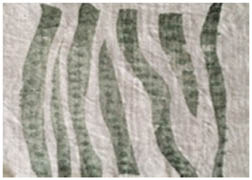 |
|---|---|---|---|---|
| Color changes | 1–2 | 1–2 | 1–2 | 1–2 |
| Acetate staining | 4–5 | 4–5 | 4–5 | 4–5 |
| Staining on cotton | 4–5 | 4–5 | 4–5 | 4–5 |
| Staining on polyamide | 4–5 | 4–5 | 4–5 | 4–5 |
| Staining on polyester | 4–5 | 4–5 | 4–5 | 4–5 |
| Staining on acrylate | 4–5 | 4–5 | 4–5 | 4–5 |
| Staining on wool | 4–5 | 4–5 | 4–5 | 4–5 |
The test results showed that the color change was related to the fastness resistance, all in the range of 1–2, which was low. This showed that the motif produced by applying the spirulina paste after going through the washing process had great potential to wear off. Similarly, the test on staining of other materials showed that it was in the range of 4–5, which was high. This showed that the washing residue had no impact on staining the other fabrics.
4 Conclusion and recommendations
Based on the results of the experiments carried out, it can be concluded that the use of Spirulina platensis as homemade natural dyes in textiles has potentials and weaknesses to be applied to home industries in Indonesia which are still running the entire production process conventionally. Potentials and weaknesses found include:
These homemade natural dyes with spirulina paste match the characteristics of the conventional handicraft industry in Indonesia, because in the process it follows the existing running production pattern, which is handmade. It has been proven that spirulina can dye fabrics by conventional ways as follows:
Unlike natural dyes derived from other plants that can be extracted using hot media, spirulina does not show optimal results. However, it can be done by making a coloring paste using a mixture of ingredients consisting of crushed spirulina, water, alginate, and glycerin.
Application of paste on two types of fabrics with different textures, namely cotton and linen, was successful. But it is still recommended to use only fabrics with natural fibers because they have the ability to bind color pigments more optimally than synthetic fabrics.
The consistency of paste using the technique of applying motifs in the form of screen printing succeeded in printing the shape of the motif well, so that in the future, the development of motifs has considerable potential.
Spirulina shows that, with mordant dyeing and fixation process, it can produce different colors, so that in the future, the potential to develop color variations is quite large.
Final result, in the form of imperfect motifs and colors, is actually one of the strengths of handicraft products that must be able to expose the imperfect character of handwork.
With a low level of fastness resistance, it is concluded that spirulina as a natural dye applied to textiles using the method in this study has no affinity. Therefore, it is not suitable as a product that requires several washes. Unless the coating process is carried out afterwards so that the color will be protected.
Acknowledgments
Thanks to Mr Danny Sukardan as Head of Research Facility and Standardization Division from Indonesian Center for Textile for his support for textile laboratory facilities and suggestions on preparing the manuscript.
-
Funding information: The authors state no funding involved.
-
Author contributions: F.C. – conceptualization, methodology, supervision, and writing (original draft and review and editing); T.H.S. – investigation and resources; M.S.R. – visualization.
-
Conflict of interest: The authors state no conflict of interest.
-
Data availability statement: All data generated or analyzed during this study are included in this published article.
References
[1] Saxena S, Raja ASM. Natural dyes: sources, chemistry, application and sustainability issues. In: Roadmap to sustainable textiles and clothing. Singapore: Springer; 2014. p. 37–80. 10.1007/978-981-287-065-0_2.Search in Google Scholar
[2] Pargai D, Jahan S, Gahlot M. Functional properties of natural dyed textiles. In: Chemistry and technology of natural and synthetic dyes and pigments. IntechOpen; 2020. 10.5772/intechopen.88933.Search in Google Scholar
[3] Rangabhashiyam S, Anu N, Selvaraju N. Sequestration of dye from textile industry wastewater using agricultural waste products as adsorbents. J Environ Chem Eng. 2013;1(4):629–41.10.1016/j.jece.2013.07.014Search in Google Scholar
[4] Khattab TA, Abdelrahman MS, Rehan M. Textile dyeing industry: environmental impacts and remediation. Env Sci Pollut Res. 2020;27:3803–18. 10.1007/s11356-019-07137-z.Search in Google Scholar PubMed
[5] Hassaan MA, Nemr AE. Health and environmental impacts of dyes: minireview. Am J Environ Sci Eng. 2017;1(3):64–7. 10.11648/j.ajese.20170103.11.Search in Google Scholar
[6] Elsahida K, Fauzi AM, Sailah I, Siregar IZ. Sustainable production of natural textile dyes industry. IOP Conf Ser: Earth Environ Sci. 2020;472:012036. 10.1088/1755-1315/472/1/012036.Search in Google Scholar
[7] Prabhu KH, Bhute AS. Plant based natural dyes and mordants: a review. J Nat Products Plant Resour. 2012;2(6):649–64.Search in Google Scholar
[8] Popescu V, Blaga AC, Pruneanu M, Cristian IN, Pîslaru M, Popescu A, et al. Green chemistry in the extraction of natural dyes from colored food waste, for dyeing protein textile materials. Polymers. 2021;13(22):3867. 10.3390/polym13223867.Search in Google Scholar PubMed PubMed Central
[9] Mulders KJM, Lamers PP, Martens DE, Wijffels RH. Phototrophic pigment production with microalgae: biological constraints and opportunities. J Phycol. 2014;50(2):229–42. 10.1111/jpy.12173.Search in Google Scholar PubMed
[10] Kamble SP, Vikhe GP, Chamle DR. Extraction and purification of phycoerythrin-a natural colouring agent from spirulina platensis. J Pharm Chem Biol Sci. 2018;6(2):78–84.Search in Google Scholar
[11] Moldovan S, Ferrandiz M, Franco E, Mira E, Capablanca L, Bonet M. Printing of cotton with eco-friendly, red algal pigment from Gracilaria sp. IOP Conf Ser: Mater Sci Eng. 2017;254:192011. 10.1088/1757-899X/254/19/192011.Search in Google Scholar
[12] Alam T, Najam L, Al Harrasi A. Extraction of natural pigments from marine algae. J Agric Mar Sci. 2018;23(1):81–91. 10.24200/jams.vol23iss1pp81-91.Search in Google Scholar
[13] Spolaore P, Joannis-Cassan C, Duran E, Isambert A. Commercial applications of microalgae. J Biosci Bioeng. 2006;101(2):87–96. 10.1263/jbb.101.87.Search in Google Scholar PubMed
[14] Balqis AS, Ciptandi F. Penerapan pewarna alam mikroalga pada benang tukel dan tenun gedog tuban. eProc Art Des. 2019;6(2):1932–40.Search in Google Scholar
[15] Ciptandi F. Innovation of motif design for traditional batik craftsmen. In: Understanding Digital Industry. Routledge; 2019. p. 302–6.10.1201/9780367814557-72Search in Google Scholar
[16] Dumasari D, Utami P, Santosa I, Aisyah DD. Marketing strategies for creative handicrafts fabricated from coconut waste based on potential market trend in Indonesia. PalArch’s J Archaeol Egypt/Egyptol. 2020;17(7):13778–86.Search in Google Scholar
[17] Qin Y, Zhang G, Chen H. The applications of alginate in functional food products. J Nutr Food Sci. 2020;3(1):100013.Search in Google Scholar
[18] Rogozhin VV, Rogozhina TV, Kurilyuk TT. Use of glycerin for preservation of grains of wheat. Agris. 2011;10:16–9.Search in Google Scholar
[19] Deveoglu O, Karadag R, Torgan E, Yildiz Y. Examination of dyeing properties of the dyed cotton fabrics with barberry (Berberis vulgaris L.). J Nat Fibers. 2020;17(8):1089–98. 10.1080/15440478.2018.1558143.Search in Google Scholar
© 2021 Fajar Ciptandi et al., published by De Gruyter
This work is licensed under the Creative Commons Attribution 4.0 International License.
Articles in the same Issue
- Regular Articles
- The nutmeg seedlings growth under pot culture with biofertilizers inoculation
- Recovery of heather (Calluna vulgaris) flowering in northern Finland
- Soil microbiome of different-aged stages of self-restoration of ecosystems on the mining heaps of limestone quarry (Elizavetino, Leningrad region)
- Conversion of land use and household livelihoods in Vietnam: A study in Nghe An
- Foliar selenium application for improving drought tolerance of sesame (Sesamum indicum L.)
- Assessment of deficit irrigation efficiency. Case study: Middle Sebou and Innaouene downstream
- Integrated weed management practices and sustainable food production among farmers in Kwara State, Nigeria
- Determination of morphological changes using gamma irradiation technology on capsicum specie varieties
- Use of maturity traits to identify optimal harvestable maturity of banana Musa AAB cv. “Embul” in dry zone of Sri Lanka
- Theory vs practice: Patterns of the ASEAN-10 agri-food trade
- Intake, nutrient digestibility, nitrogen, and mineral balance of water-restricted Xhosa goats supplemented with vitamin C
- Physicochemical properties of South African prickly pear fruit and peel: Extraction and characterisation of pectin from the peel
- An evaluation of permanent crops: Evidence from the “Plant the Future” project, Georgia
- Probing of the genetic components of seedling emergence traits as selection indices, and correlation with grain yield characteristics of some tropical maize varieties
- Increase in the antioxidant content in biscuits by infusions or Prosopis chilensis pod flour
- Altitude, shading, and management intensity effect on Arabica coffee yields in Aceh, Indonesia
- Climate change adaptation and cocoa farm rehabilitation behaviour in Ahafo Ano North District of Ashanti region, Ghana
- Effect of light spectrum on growth, development, and mineral contents of okra (Abelmoschus esculentus L.)
- An assessment of broiler value chain in Nigeria
- Storage root yield and sweetness level selection for new honey sweet potato (Ipomoea batatas [L.] Lam)
- Direct financial cost of weed control in smallholder rubber plantations
- Combined application of poultry litter biochar and NPK fertilizer improves cabbage yield and soil chemical properties
- How does willingness and ability to pay of palm oil smallholders affect their willingness to participate in Indonesian sustainable palm oil certification? Empirical evidence from North Sumatra
- Investigation of the adhesion performance of some fast-growing wood species based on their wettability
- The choice of information sources and marketing channel of Bali cattle farmers in Bali Province
- Preliminary phytochemical screening and in vitro antibacterial activity of Plumbago indica (Laal chitrak) root extracts against drug-resistant Escherichia coli and Klebsiella pneumoniae
- Agronomic and economic performance of maize (Zea mays L.) as influenced by seed bed configuration and weed control treatments
- Selection and characterization of siderophores of pathogenic Escherichia coli intestinal and extraintestinal isolates
- Effectiveness of cowpea (Vigna unguiculata L.) living mulch on weed suppression and yield of maize (Zea mays L.)
- Cow milk and its dairy products ameliorate bone toxicity in the Coragen-induced rat model
- The motives of South African farmers for offering agri-tourism
- Morphophysiological changes and reactive oxygen species metabolism in Corchorus olitorius L. under different abiotic stresses
- Nanocomposite coatings for hatching eggs and table eggs
- Climate change stressors affecting household food security among Kimandi-Wanyaga smallholder farmers in Murang’a County, Kenya
- Genetic diversity of Omani barley (Hordeum vulgare L.) germplasm
- Productivity and profitability of organic and conventional potato (Solanum tuberosum L.) production in West-Central Bhutan
- Response of watermelon growth, yield, and quality to plant density and variety in Northwest Ethiopia
- Sex allocation and field population sex ratio of Apanteles taragamae Viereck (Hymenoptera: Braconidae), a larval parasitoid of the cucumber moth Diaphania indica Saunders (Lepidoptera: Crambidae)
- Comparison of total nutrient recovery in aquaponics and conventional aquaculture systems
- Relationships between soil salinity and economic dynamics: Main highlights from literature
- Effects of soil amendments on selected soil chemical properties and productivity of tef (Eragrostis tef [Zucc.] Trotter) in the highlands of northwest Ethiopia
- Influence of integrated soil fertilization on the productivity and economic return of garlic (Allium sativum L.) and soil fertility in northwest Ethiopian highlands
- Physiological and biochemical responses of onion plants to deficit irrigation and humic acid application
- The incorporation of Moringa oleifera leaves powder in mutton patties: Influence on nutritional value, technological quality, and sensory acceptability
- Response of biomass, grain production, and sugar content of four sorghum plant varieties (Sorghum bicolor (L.) Moench) to different plant densities
- Assessment of potentials of Moringa oleifera seed oil in enhancing the frying quality of soybean oil
- Influences of spacing on yield and root size of carrot (Daucus carota L.) under ridge-furrow production
- Review Articles
- A review of upgradation of energy-efficient sustainable commercial greenhouses in Middle East climatic conditions
- Plantago lanceolata – An overview of its agronomically and healing valuable features
- Special Issue on CERNAS 2020
- The role of edible insects to mitigate challenges for sustainability
- Morphology and structure of acorn starches isolated by enzymatic and alkaline methods
- Evaluation of FT-Raman and FTIR-ATR spectroscopy for the quality evaluation of Lavandula spp. Honey
- Factors affecting eating habits and knowledge of edible flowers in different countries
- Ideal pH for the adsorption of metal ions Cr6+, Ni2+, Pb2+ in aqueous solution with different adsorbent materials
- Determination of drying kinetics, specific energy consumption, shrinkage, and colour properties of pomegranate arils submitted to microwave and convective drying
- Eating habits and food literacy: Study involving a sample of Portuguese adolescents
- Characterization of dairy sheep farms in the Serra da Estrela PDO region
- Development and characterization of healthy gummy jellies containing natural fruits
- Agro-ecological services delivered by legume cover crops grown in succession with grain corn crops in the Mediterranean region
- Special issue on CERNAS 2020: Message from the Editor
- Special Issue on ICESAT 2019
- Climate field schools to increase farmers’ adaptive capacity to climate change in the southern coastline of Java
- Special Issue on the International Conference on Agribusiness and Rural Development - IConARD 2020
- Supply chain efficiency of red chili based on the performance measurement system in Yogyakarta, Indonesia
- Sustainable value of rice farm based on economic efficiency in Yogyakarta, Indonesia
- Enhancing the performance of conventional coffee beans drying with low-temperature geothermal energy by applying HPHE: An experimental study
- Opportunities of using Spirulina platensis as homemade natural dyes for textiles
- Special Issue on the APA 2019 - 11th Triennial Conference
- Expanding industrial uses of sweetpotato for food security and poverty alleviation
- A survey on potato productivity, cultivation and management constraints in Mbala district of Northern Zambia
- Orange-fleshed sweetpotato: Strategies and lessons learned for achieving food security and health at scale in Sub-Saharan Africa
- Growth and yield of potato (Solanum tuberosum L.) as affected by storage conditions and storage duration in Jos, Plateau State, Nigeria
- Special Issue on the International Conference on Multidisciplinary Research - Agrarian Sciences
- Application of nanotechnologies along the food supply chain
- Special Issue on Agriculture, Climate Change, Information Technology, Food and Animal (ACIFAS 2020)
- The use of endophytic growth-promoting bacteria to alleviate salinity impact and enhance the chlorophyll, N uptake, and growth of rice seedling
Articles in the same Issue
- Regular Articles
- The nutmeg seedlings growth under pot culture with biofertilizers inoculation
- Recovery of heather (Calluna vulgaris) flowering in northern Finland
- Soil microbiome of different-aged stages of self-restoration of ecosystems on the mining heaps of limestone quarry (Elizavetino, Leningrad region)
- Conversion of land use and household livelihoods in Vietnam: A study in Nghe An
- Foliar selenium application for improving drought tolerance of sesame (Sesamum indicum L.)
- Assessment of deficit irrigation efficiency. Case study: Middle Sebou and Innaouene downstream
- Integrated weed management practices and sustainable food production among farmers in Kwara State, Nigeria
- Determination of morphological changes using gamma irradiation technology on capsicum specie varieties
- Use of maturity traits to identify optimal harvestable maturity of banana Musa AAB cv. “Embul” in dry zone of Sri Lanka
- Theory vs practice: Patterns of the ASEAN-10 agri-food trade
- Intake, nutrient digestibility, nitrogen, and mineral balance of water-restricted Xhosa goats supplemented with vitamin C
- Physicochemical properties of South African prickly pear fruit and peel: Extraction and characterisation of pectin from the peel
- An evaluation of permanent crops: Evidence from the “Plant the Future” project, Georgia
- Probing of the genetic components of seedling emergence traits as selection indices, and correlation with grain yield characteristics of some tropical maize varieties
- Increase in the antioxidant content in biscuits by infusions or Prosopis chilensis pod flour
- Altitude, shading, and management intensity effect on Arabica coffee yields in Aceh, Indonesia
- Climate change adaptation and cocoa farm rehabilitation behaviour in Ahafo Ano North District of Ashanti region, Ghana
- Effect of light spectrum on growth, development, and mineral contents of okra (Abelmoschus esculentus L.)
- An assessment of broiler value chain in Nigeria
- Storage root yield and sweetness level selection for new honey sweet potato (Ipomoea batatas [L.] Lam)
- Direct financial cost of weed control in smallholder rubber plantations
- Combined application of poultry litter biochar and NPK fertilizer improves cabbage yield and soil chemical properties
- How does willingness and ability to pay of palm oil smallholders affect their willingness to participate in Indonesian sustainable palm oil certification? Empirical evidence from North Sumatra
- Investigation of the adhesion performance of some fast-growing wood species based on their wettability
- The choice of information sources and marketing channel of Bali cattle farmers in Bali Province
- Preliminary phytochemical screening and in vitro antibacterial activity of Plumbago indica (Laal chitrak) root extracts against drug-resistant Escherichia coli and Klebsiella pneumoniae
- Agronomic and economic performance of maize (Zea mays L.) as influenced by seed bed configuration and weed control treatments
- Selection and characterization of siderophores of pathogenic Escherichia coli intestinal and extraintestinal isolates
- Effectiveness of cowpea (Vigna unguiculata L.) living mulch on weed suppression and yield of maize (Zea mays L.)
- Cow milk and its dairy products ameliorate bone toxicity in the Coragen-induced rat model
- The motives of South African farmers for offering agri-tourism
- Morphophysiological changes and reactive oxygen species metabolism in Corchorus olitorius L. under different abiotic stresses
- Nanocomposite coatings for hatching eggs and table eggs
- Climate change stressors affecting household food security among Kimandi-Wanyaga smallholder farmers in Murang’a County, Kenya
- Genetic diversity of Omani barley (Hordeum vulgare L.) germplasm
- Productivity and profitability of organic and conventional potato (Solanum tuberosum L.) production in West-Central Bhutan
- Response of watermelon growth, yield, and quality to plant density and variety in Northwest Ethiopia
- Sex allocation and field population sex ratio of Apanteles taragamae Viereck (Hymenoptera: Braconidae), a larval parasitoid of the cucumber moth Diaphania indica Saunders (Lepidoptera: Crambidae)
- Comparison of total nutrient recovery in aquaponics and conventional aquaculture systems
- Relationships between soil salinity and economic dynamics: Main highlights from literature
- Effects of soil amendments on selected soil chemical properties and productivity of tef (Eragrostis tef [Zucc.] Trotter) in the highlands of northwest Ethiopia
- Influence of integrated soil fertilization on the productivity and economic return of garlic (Allium sativum L.) and soil fertility in northwest Ethiopian highlands
- Physiological and biochemical responses of onion plants to deficit irrigation and humic acid application
- The incorporation of Moringa oleifera leaves powder in mutton patties: Influence on nutritional value, technological quality, and sensory acceptability
- Response of biomass, grain production, and sugar content of four sorghum plant varieties (Sorghum bicolor (L.) Moench) to different plant densities
- Assessment of potentials of Moringa oleifera seed oil in enhancing the frying quality of soybean oil
- Influences of spacing on yield and root size of carrot (Daucus carota L.) under ridge-furrow production
- Review Articles
- A review of upgradation of energy-efficient sustainable commercial greenhouses in Middle East climatic conditions
- Plantago lanceolata – An overview of its agronomically and healing valuable features
- Special Issue on CERNAS 2020
- The role of edible insects to mitigate challenges for sustainability
- Morphology and structure of acorn starches isolated by enzymatic and alkaline methods
- Evaluation of FT-Raman and FTIR-ATR spectroscopy for the quality evaluation of Lavandula spp. Honey
- Factors affecting eating habits and knowledge of edible flowers in different countries
- Ideal pH for the adsorption of metal ions Cr6+, Ni2+, Pb2+ in aqueous solution with different adsorbent materials
- Determination of drying kinetics, specific energy consumption, shrinkage, and colour properties of pomegranate arils submitted to microwave and convective drying
- Eating habits and food literacy: Study involving a sample of Portuguese adolescents
- Characterization of dairy sheep farms in the Serra da Estrela PDO region
- Development and characterization of healthy gummy jellies containing natural fruits
- Agro-ecological services delivered by legume cover crops grown in succession with grain corn crops in the Mediterranean region
- Special issue on CERNAS 2020: Message from the Editor
- Special Issue on ICESAT 2019
- Climate field schools to increase farmers’ adaptive capacity to climate change in the southern coastline of Java
- Special Issue on the International Conference on Agribusiness and Rural Development - IConARD 2020
- Supply chain efficiency of red chili based on the performance measurement system in Yogyakarta, Indonesia
- Sustainable value of rice farm based on economic efficiency in Yogyakarta, Indonesia
- Enhancing the performance of conventional coffee beans drying with low-temperature geothermal energy by applying HPHE: An experimental study
- Opportunities of using Spirulina platensis as homemade natural dyes for textiles
- Special Issue on the APA 2019 - 11th Triennial Conference
- Expanding industrial uses of sweetpotato for food security and poverty alleviation
- A survey on potato productivity, cultivation and management constraints in Mbala district of Northern Zambia
- Orange-fleshed sweetpotato: Strategies and lessons learned for achieving food security and health at scale in Sub-Saharan Africa
- Growth and yield of potato (Solanum tuberosum L.) as affected by storage conditions and storage duration in Jos, Plateau State, Nigeria
- Special Issue on the International Conference on Multidisciplinary Research - Agrarian Sciences
- Application of nanotechnologies along the food supply chain
- Special Issue on Agriculture, Climate Change, Information Technology, Food and Animal (ACIFAS 2020)
- The use of endophytic growth-promoting bacteria to alleviate salinity impact and enhance the chlorophyll, N uptake, and growth of rice seedling

